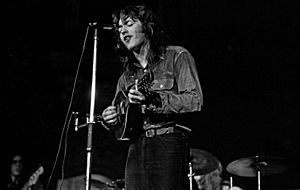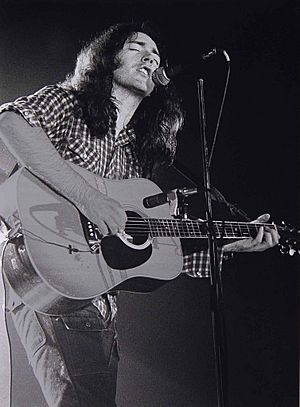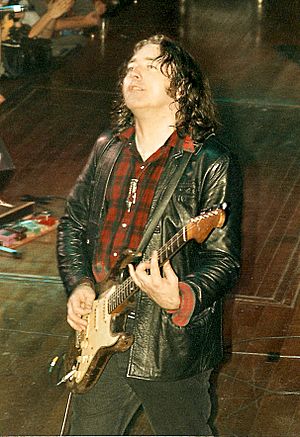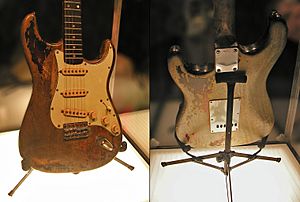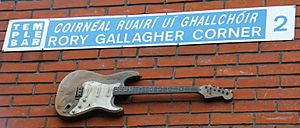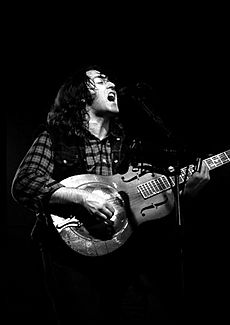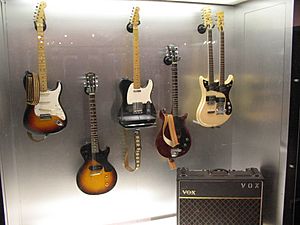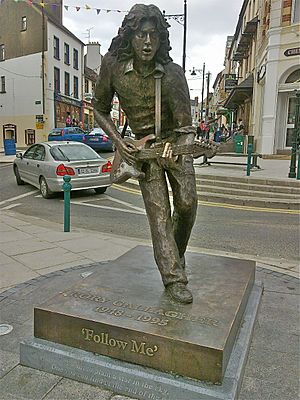Rory Gallagher facts for kids
Quick facts for kids
Rory Gallagher
|
|
|---|---|
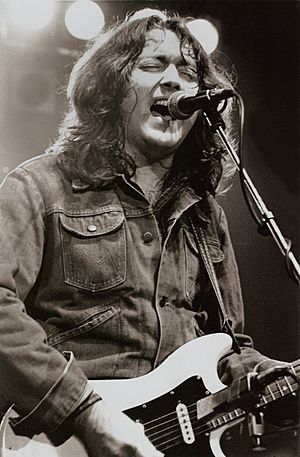
Gallagher performing at the Manchester Apollo in 1982
|
|
| Background information | |
| Birth name | William Rory Gallagher |
| Born | 2 March 1948 Ballyshannon, Ireland |
| Origin | Cork, Ireland |
| Died | 14 June 1995 (aged 47) London, England |
| Genres | |
| Occupation(s) |
|
| Instruments |
|
| Years active | 1963–1995 |
| Labels |
|
William Rory Gallagher (2 March 1948 – 14 June 1995) was an Irish guitarist, singer, and songwriter. He was famous for his amazing guitar playing. Many people called him "the greatest guitarist you've never heard of."
Other famous guitarists like Alex Lifeson from Rush, Brian May from Queen, and Eric Clapton said Rory Gallagher inspired them. In 1972, Melody Maker magazine named him Guitarist of the Year. Rolling Stone magazine also put him at number 57 on their list of the greatest guitarists ever in 2015.
Gallagher started a blues rock band called Taste in 1966. They had some success in the United Kingdom. After Taste broke up, he started a solo career. He released music through the 1970s and 1980s. He sold over 30 million records around the world.
Rory Gallagher's popularity went down in the 1980s. This was due to changes in the music world and his health. He had a liver transplant in 1995. Sadly, he died later that year in London at age 47 from health problems.
Contents
Early Life and Music Journey
Rory Gallagher was born in Ballyshannon, County Donegal, Ireland, in 1948. His parents, Daniel and Monica, loved music. His father played the accordion, and his mother sang and acted.
In 1949, his family moved to Derry City. His younger brother, Dónal, was born there. Dónal later became Rory's manager for most of his career. In 1956, Rory, his mother, and brother moved to Cork.
Rory showed musical talent very early. He taught himself to play the ukulele. When he was nine, his parents gave him a guitar. He started playing at small events. At age twelve, he won a talent contest and used the prize money to buy a new guitar.
Three years later, in 1963, he bought a 1961 Fender Stratocaster guitar. This guitar became his main instrument. It was the one he was most known for throughout his career.
Rory first loved skiffle music after hearing Lonnie Donegan on the radio. Donegan often played covers of blues and folk songs from the United States. Rory learned about music from radio shows and TV. He would stay up late to listen to Radio Luxembourg and AFN. This was how he found out about the blues musicians he admired.
Some of his early inspirations included Woody Guthrie, Big Bill Broonzy, and Lead Belly. Rory taught himself to play slide guitar and the harmonica. Over the next few years, he also learned to play the alto saxophone, bass, mandolin, banjo, and the Coral electric sitar. By his mid-teens, he was trying out many different blues styles.
While still a teenager, Rory started playing with Irish showbands after school. In 1963, he joined a band called Fontana. They played popular songs of the day. The band toured Ireland and the United Kingdom. Rory started to change the band's music. By 1965, he had turned Fontana into "The Impact," an R&B group. They played in Ireland and Spain. The band later broke up in London. In 1966, Rory went back to Ireland. He decided to form his own band in Cork.
Forming the Band Taste
After playing in showbands, Rory Gallagher formed "The Taste" in 1966. It was later just called "Taste." This was a blues rock and R&B band with three members. At first, it was Rory with two musicians from Cork, Eric Kitteringham and Norman Damery. But by 1968, they were replaced by John Wilson (drums) and Richard McCracken (bass).
The band played many shows in the UK. They often performed at the Marquee Club. They also opened for famous bands like Cream and Blind Faith. Taste released two studio albums, Taste and On The Boards. They also released two live albums, Live Taste and Live at the Isle of Wight.
Taste broke up soon after playing at the 1970 Isle of Wight Festival. Rory said the band members wanted to play different kinds of music. He also had problems with their manager. This caused him legal trouble and he couldn't play for six months. Rory's brother, Dónal, became his manager. He helped Rory take the old manager to court to get back money they were owed. Because of this, Rory was careful about signing big management deals later on. He even turned down an offer from Led Zeppelin's manager, Peter Grant.
Rory's Solo Career
After Taste broke up, Rory Gallagher started touring under his own name. He hired Gerry McAvoy to play bass. Their first album was called Rory Gallagher. This started a 20-year musical partnership between Rory and Gerry. The drummer was Wilgar Campbell.
The 1970s were a very busy time for Rory. He released ten albums during that decade. These included two live albums: Live! in Europe and Irish Tour '74. In 1972, he was named Melody Maker's Guitarist of the Year. Even though many of his albums were popular in the UK, he didn't become a huge superstar.
Rory Gallagher was known for his long, energetic live shows. A film called Irish Tour '74 shows his amazing performances. During times of trouble in Northern Ireland, many artists avoided playing there. But Rory always made sure to play there at least once a year. He even stayed in the Europa Hotel in Belfast, which was known as "the most bombed hotel in Europe." This made him very popular with his fans. He became a role model for young Irish musicians.
In 1975, Rory signed with a new record company, Chrysalis Records. He liked to have full control over his music. For example, when making the album Calling Card, he didn't want the producer to change his sound. He also didn't want to shorten his song "Edged in Blue" to make it a single. Other albums from this time include Photo-Finish and Top Priority.
Rory's band played on many TV and radio shows in Europe. He also worked with other famous musicians like Jerry Lee Lewis and Muddy Waters. In the 1980s, he kept recording albums like Jinx, Defender, and Fresh Evidence. After Fresh Evidence, he toured the United States. He also played with Box of Frogs, a band made of former members of The Yardbirds. Rory was very focused on details and sometimes doubted himself, but he always had loyal fans.
Band Members Over Time
Besides Rory Gallagher on guitar and vocals, his band members changed over the years:
- 1971–1972: Gerry McAvoy (bass) and Wilgar Campbell (drums).
- 1972–1978: Gerry McAvoy (bass), Lou Martin (keyboards), and Rod de'Ath (drums).
- 1978–1981: Gerry McAvoy (bass) and Ted McKenna (drums).
- 1981–1991: Gerry McAvoy (bass), Brendan O'Neill (drums). Mark Feltham often joined on harmonica.
- 1992–1994: David Levy (bass), Jim Leverton (keyboards), John Cooke (keyboards), Richard Newman (drums). Mark Feltham often joined on harmonica.
Rory's Guitars and Gear
His Famous Stratocaster
Rory Gallagher played a very worn 1961 Stratocaster guitar for many years. It was said to be the first one in Ireland. Rory bought it used in 1963 for just under £100. His brother Dónal said that Rory's dream was to have a guitar like Buddy Holly. Rory told his mother that with this guitar, he could play both rhythm and lead parts, meaning they wouldn't need another musician, and he could earn more money to pay for it. This Stratocaster became his musical partner for life.
Most of the paint on Rory's Stratocaster was worn off over time. He kept the guitar in good playing condition but never had it repainted. He believed that less paint on a guitar made the wood "breathe more" and sound better. His brother Dónal also said that Rory's sweat was very acidic, which caused the paint to wear off faster.
Rory changed his guitar quite a bit. He replaced the tuning pegs and the nut many times. The pickguard was also changed. Only the middle pick-up is original. He also changed the wiring so he had one main tone control and one main volume control. He put in a five-way switch instead of the old three-way one.
In 2011, Rory's brother Dónal let guitarist Joe Bonamassa play Rory's Stratocaster at two concerts in London. Bonamassa opened both shows playing "Cradle Rock" with Rory's guitar.
Other Equipment
While known for his Stratocaster, Rory also used other guitars, including acoustic ones. In 2014, one of his last guitars, a custom-built Patrick Eggle 'JS Berlin Legend', was sold for £25,000.
Rory used different kinds of amplifiers. He usually liked smaller 'combo' amplifiers instead of the big Marshall 'stacks' that other rock guitarists used. To get enough sound on stage, he would connect several smaller amps together.
When he was with Taste, he used a Vox AC30 amp with a Dallas Rangemaster treble booster. He also used an Ibanez Tube Screamer and several Boss effects, like a flanger. Later, he started using Fender amplifiers. In the late 1970s, as his sound became heavier, he tried Ampeg amps and Marshall combos.
Rory was one of the first to use Boss ME-5 all-in-one effects units. He used one for his live shows until he passed away.
His Passing
In his later years, Rory Gallagher had some health problems. He was admitted to London's King's College Hospital in March 1995. Doctors found that his liver was failing. They decided a liver transplant was his only option. After 13 weeks in intensive care, his health suddenly got worse when he got a serious infection. He died on 14 June 1995, at age 47. He was not married and had no children.
Rory Gallagher was buried in St Oliver's Cemetery, near Cork City, Ireland. His gravestone looks like an award he received in 1972 for International Guitarist of the Year.
Rory's Legacy
In 2003, Rory's brother Dónal released Wheels Within Wheels. This album was a collection of acoustic songs Rory had recorded. It featured other musicians like Bert Jansch, Martin Carthy, The Dubliners, and Lonnie Donegan.
Many musicians today say Rory Gallagher inspired them when they were starting out. These include The Edge from U2, Slash from Guns N' Roses, Johnny Marr from the Smiths, and Joe Bonamassa.
Brian May, the lead guitarist of Queen, shared a story. He said that when he was a kid, he asked Rory Gallagher how he got his guitar sound. Rory told him, and Brian May said, "So I owe Rory Gallagher my sound." In 2010, Gibson.com ranked Rory as the 42nd greatest guitarist of all time. Rolling Stone magazine put him at 57th place on their list of the 100 Greatest Guitarists. Eric Clapton also said Rory helped him "get back into the blues."
Tributes to Rory
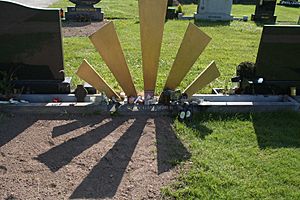
- In 1997, a sculpture honoring Rory Gallagher was put up in Cork. The area was renamed Rory Gallagher Place.
- In Dublin, Rory Gallagher Corner has a life-size bronze statue of his Stratocaster guitar.
- The Rory Gallagher Music Library opened in Cork in 2004.
- In 2006, a plaque was put up at the Ulster Hall in Belfast.
- A street in Ris-Orangis, France, was renamed Rue Rory Gallagher.
- The band Black 47 released a song called "Rory" in 1996 to honor him.
- Christy Moore released a song called 'Rory is Gone' in 2009.
- In 2010, a life-sized bronze statue of Rory Gallagher was put up in Ballyshannon. An annual blues festival is held there in his honor.
- In 2015, Fender made a Rory Gallagher Signature Stratocaster guitar.
- In 2016, a statue of Rory was approved for Bedford Street in Belfast, near Ulster Hall.
Selected Albums
Rory Gallagher released 14 albums during his solo career, including 3 live albums:
- Rory Gallagher (1971)
- Deuce (1971)
- Live in Europe (1972)
- Blueprint (1973)
- Tattoo (1973)
- Irish Tour '74 (1974)
- Against the Grain (1975)
- Calling Card (1976)
- Photo-Finish (1978)
- Top Priority (1979)
- Stage Struck (1980)
- Jinx (1982)
- Defender (1987)
- Fresh Evidence (1990)
Images for kids
See also
 In Spanish: Rory Gallagher para niños
In Spanish: Rory Gallagher para niños
- List of people on stamps of Ireland (2002)
- List of blues musicians


